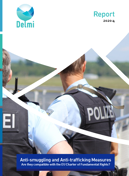The policy brief clarifies the difference and the similarities between human trafficking and human trafficking, two concepts that often recur and are confused in the general debate on migration, the legal regulations around the two concepts are also clarified. The Policy Brief highlights some of the risks involved in being smuggled across national borders and the dangers of people exposed to human trafficking being classified as irregular migrants. The text also highlights a number of policy recommendations, including state obligations regarding human rights towards people who are at risk of human trafficking or being abused by smugglers. A key question is how can states effectively protect people from being trafficked?
Some overall conclusions and recommendations
- In order for states to be able to fulfill their obligations to identify, assist and protect those who have been smuggled or victims of human trafficking, officials must get an appropriate education.
- States must be fully aware of their obligations to protect and assist people exposed to human trafficking and human trafficking within their borders. These include obligations to provide immediate assistance, including the provision of protection, housing and nutrition, as well as long-term obligations that include education for children, safe repatriation or international protection.
- Minors, especially unaccompanied minors, are special
exposed to being exploited and exploited. States should
provide facilities and competent staff who can meet the need for support and care for this group.
About the author
The Policy Brief, Human Trafficking and Smuggling in the Migration Context: Challenges and Lessons (2018:7), is written by Ryszard Piotrowicz, Professor of Law at Aberystwyth University, Wales, and Second Vice-President of GRETA, the Council of Europe’s Group of Experts on Action against human trafficking.
Pictture by Florian Olivio from Unsplash.

